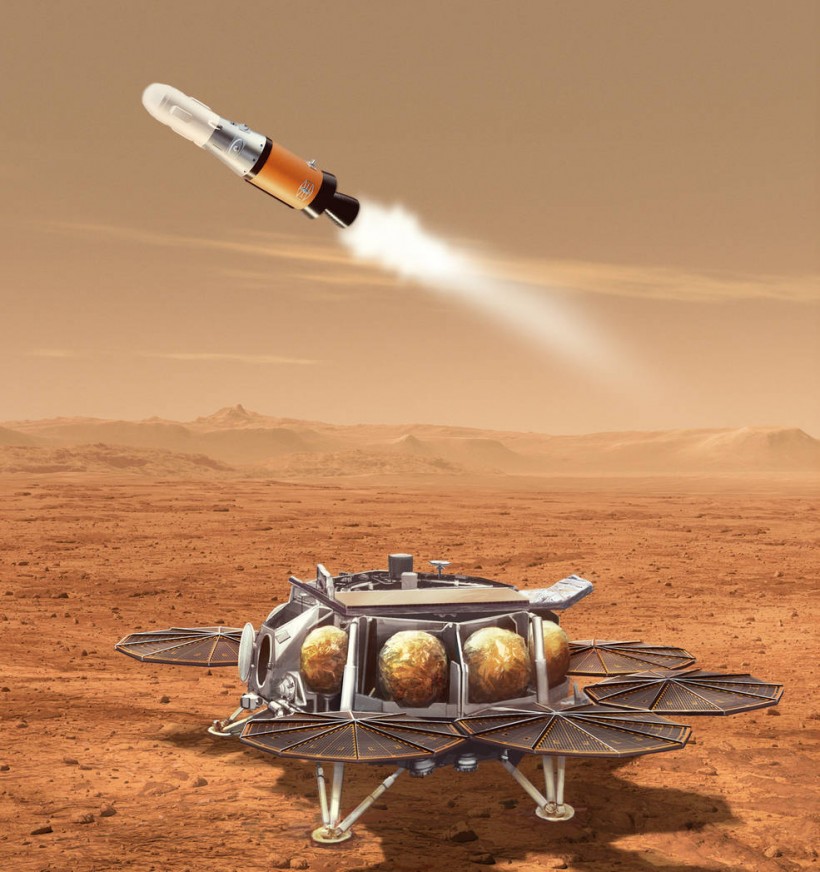NASA and the European Space Agency (ESA) will soon share new information and strategies for returning the Mars Sample Return to Earth results.
On July 27, at 11 a.m. EDT, the space agencies are anticipated to have a media teleconference to go through the design of their Mars Sample Return program. NASA will live stream the teleconference online through its official website.

This illustration shows a concept for a proposed NASA Mars lander-and-rocket combination that would play a key role in returning to Earth samples of Mars material collected by the Perseverance rover. This Sample Retrieval Lander would carry a small rocket (about 10 feet, or 3 meters, tall) called the Mars Ascent Vehicle to the Martian surface. After using a robotic arm to load the rover’s sealed sample tubes into a container in the nose cone of the rocket, the lander would launch the Mars Ascent Vehicle into orbit around the Red Planet.
NASA, ESA to Reveal Mars Sample Return Plans
NASA and ESA stated that they recently held a systems requirement review as part of the conceptual design stage of the Mars Sample Return mission. The architecture plan, which is scheduled to be finished in September 2022, will be presented at the briefing.
The space agency officials who will join the teleconference include:
- David Parker, ESA's director of Human and Robotic Exploration;
- Francois Spoto, ESA's head of Mars exploration group;
- Jeff Gramling, NASA's director of Mars Sample Return Program;
- Thomas Zurbuchen, NASA associate administrator of Science Mission Directorate
By returning carefully chosen samples for analysis with the most cutting-edge tools available on Earth, the Mars Sample Return program may completely transform how humankind views Mars. The first mission to bring back samples from another planet and the first launch from the surface of another planet will be accomplished through this strategic relationship with ESA.
The materials to be returned are believed to represent the best chance to uncover the early development of Mars, including the possibility of life. Perseverance is presently gathering these samples while exploring Jezero Crater, home to an old river delta.
According to Space.com, the project's goal is to return to Earth as soon as 2033 using Martian samples collected by the Perseverance rover. The objective is to enable researchers to examine the samples for any evidence of early Martian life as well as details on how the Red Planet changed through the ages.
The fetch rover will load the MAV with the cache it has collected from Perseverance while gathering data in Mars' Jezero Crater. The samples will subsequently be launched by the MAV and sent to Mars orbit, where they will be transferred to an ESA-provided Earth-return orbiter for return to Earth.
The second lander extends the mission's duration by two years, to 2028, and another two years, to 2031, for the mission's return to Earth.
Consultations on Mars Landers
Another Space.com report mentioned that NASA requested public feedback on an environmental assessment for the mission through online submissions and two virtual public meetings. NASA officials underscored that the organization will consider these suggestions when the task is developed and intends to publish a draft environmental impact statement later in 2022.
When the alliance opted to create a second lander because of the mission's mass requirements in March, the design underwent a significant alteration. While the second lander will carry an ESA-built "fetch rover" to collect Perseverance's samples, the first lander will carry a NASA-developed Mars ascent vehicle (MAV) to the planet's surface.
The updated strategy, according to NASA officials, is "consistent" with the Mars Sample Return Independent Review Board's (IRB) finding that a dual-lander architecture may improve the probability of mission success.
RELATED ARTICLE: Moon Gardening: Experiments of Growing Plants on 'Lunar Regolith' Yield Promising Results
Check out more news and information on Space in Science Times.














